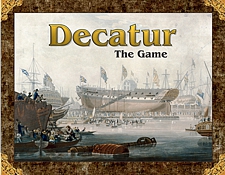
Decatur How to PlayConsider the game of Chess. The rules tell you how all the pieces move (bishop moves diagonally), and how you win (checkmate the opposing king). But they don't tell you how to play. When you set up the pieces for the first time, you're wondering, "Hey, there's sixteen pieces, which do I move first?" "What intermediate things am I trying to accomplish?" "My opponent just forked my rook! Nobody told me about that!" The same is true of Decatur. The rules simply tell you what's legal to do. They don't tell you what you ought to do. In other words, how to play. (By the way, in most other respects, Decatur is not like Chess.) Now the best way to learn to play Decatur, is to actually play Decatur. Read the rules once or twice, then set up the pieces and just start playing. Reading the rulebook another time is like trying to learn to drive a car by reading the owner's manual. There is no substitute for getting behind the wheel.
When it's your turn, don't spend minutes on end trying to foresee every last repercussion. Just quickly pick an action that seems reasonable, do it, and see what happens. Play a couple intervals that way, and you will discover the game. Drive the car. Since You're Going to Ignore this Advice Anyway...We will now attempt a written description of what it's like to drive the car. Decatur is a real estate investment game. Ignore what the board looks like. We repeat: Decatur is a real estate investment game. We will defend this statement later, but keep it in mind. The victory conditions are to have the most factors on the board -- that's pretty clear. How do we achieve this? Well, on page two of the rules there's an expand action that allows a player to add factors to the board. That's obviously the way to go, right? Not So Fast...The crux of the game is the economic upheaval described at the top of the last page. At the end of an interval, all regions will be ranked from most to least prosperous. So for example, let's say Africa turns up as the most prosperous. And let's say that you control Congo Basin, South Africa, and Madagascar, with two factors in each location, for a pre-upheaval total of six.
Now you adjust the locations according to the rules. All controlled locations in Africa (the most prosperous region) are adjusted to have four factors. Therefore you add two more factors to each location. Post-upheaval then, your total becomes twelve. You just doubled your factors! There's more. Let's run that scenario again, only this time, let's suppose you begin with one factor instead of two in each location, for a pre-upheaval total of three. What happens? As before, you adjust the locations to have four factors. Therefore you add three more factors to each location, for a post-upheaval total of twelve. In both cases you ended up with twelve factors. But notice -- it did not matter how many factors you had before. All that mattered was how many locations you controlled. Since you controlled three locations in Africa, you ended up with twelve factors. Had you controlled four locations, you would have ended up with sixteen factors. This point cannot be stressed too strongly -- until the end of them game when you count everything up, it does not matter how many factors you have on the board. It only matters how many locations you have. The more, the better. Quality vs. QuantityOf course, going in, you don't know that Africa is going to be the most prosperous. Therefore, pay attention to the prosperity cards. And pay attention to the actions of the other players. (Their actions betray the information they have that you don't.) If you do that, you may not know for sure that an African location will be worth exactly four, but you will know that it is relatively high (say, three or four). We repeat: Decatur is a real estate investment game. Which Actions?Seven possible player actions seem like a lot. Fortunately, at the beginning there are only two, and after that, practically four. On your first turn, you can only draw an influence card or restructure. None of the other actions are possible. After you restructure the first time, realize that the exchange and restructure actions are only there in case of exceptional need -- either because you have a fistful of the wrong kind of influence card or because you have so few factors you may as well reboot. That gets us down to five actions. If you think of consolidate and venture as two slightly different types of move, that leaves us with four. So on a typical turn, think of your options as:
The Hostile Takeover in PracticeAt the start of the second interval, you may find that you want to acquire a location that is already occupied. Worse, you often find you have to cross an ocean to do it, and this grants two additional points (logistics) to the defender. There are several means to overcome this. First, choose targets that match your influence cards. Those cards also are worth two points. Second, build a port on the ocean next to your intended target. The associated fleet contributes another point to your cause. Lastly, use the consolidate action to pile seven factors together in a location from which you intend to venture. Now, you might balk at this, as it leaves vulnerable the locations from which you draw factors. But ask yourself this -- are those locations worth more than where you're going? EpilogueYou've read the owner's manual. It's time to drive the car.
Copyright 2021 Jim Swift |